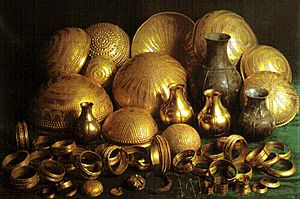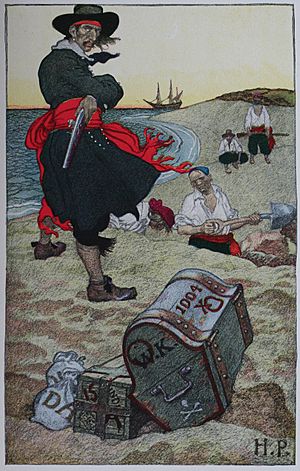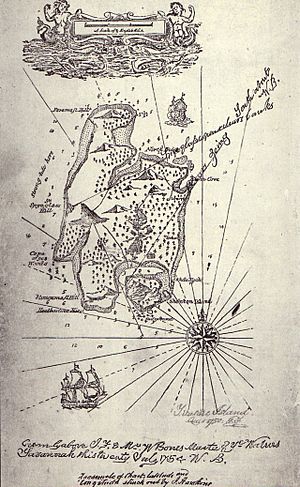Treasure facts for kids

A treasure is a large collection of valuable things. These are often riches from a long time ago. People usually think of treasure as something that was lost or forgotten, then found again. Some countries even have laws about what counts as treasure when it is discovered.
Sometimes, people talk about "blood and treasure" or "lives and treasure." This means the human lives and money spent on big projects, like a war.
Contents
Treasure Hunting


Looking for hidden treasure is a popular idea in stories and legends. But real-life treasure hunters also exist. They search for lost wealth, sometimes as their job.
Buried Treasure
Many popular stories about pirates include buried treasure. People often imagine pirates hiding their stolen riches in secret places. They plan to come back for it later, often using a treasure map.
Three famous stories helped make the idea of buried pirate treasure so popular:
- "The Gold-Bug" by Edgar Allan Poe
- "Wolfert Webber" by Washington Irving
- Treasure Island by Robert Louis Stevenson
These stories are different, but they all got ideas from the legend of William Kidd. Stevenson's Treasure Island was especially influenced by Irving's "Wolfert Webber." Stevenson even said that much of his story's spirit and details came from Irving's work.
Treasure Maps
A treasure map is a special kind of map. It shows where a hidden treasure, a lost mine, or a secret place is located. Treasure maps are much more common in fiction than in real life. "Pirate treasure maps" in stories often look hand-drawn. They usually have mysterious clues for the characters to follow.
The Copper Scroll
One of the oldest known documents that lists buried treasure is the copper scroll. It was found with the Dead Sea scrolls near Qumran in 1952. Experts believe it was written between 50 and 100 AD. The scroll lists 63 places with detailed directions to hidden gold and silver treasures.
Here are the first few lines of the Copper Scroll:
1:1 In the ruin which is in the valley of Acor, under
1:2 the steps leading to the East,
1:3 forty long cubits: a chest of silver and its vessels
1:4 with a weight of seventeen talents. KEN
So far, none of the items mentioned in the scroll have been found. Scholars still debate if the copper scroll describes real buried treasures. They also wonder about the total amounts and who owned them.
Pirates and Ships
Even though buried pirate treasure is a favorite story idea, there are very few real cases of pirates actually burying treasure. There are no known cases of a real historical pirate treasure map.
One documented case of buried treasure involved Francis Drake. He buried Spanish gold and silver after attacking a town called Nombre de Dios. Drake later returned and dug up the loot. He then sailed back to England. He did not make a map.
Another case in 1720 involved British Captain Stratton. He supposedly traded rum with pirates in the Caribbean. He then buried his gold near the mouth of the Chesapeake Bay. Two of his crew members told the authorities about him. It is thought the gold was found. Captain Stratton was not a pirate, and he did not make a map.
The pirate most connected to the legends of buried treasure is Captain Kidd. The story said that Kidd buried treasure from a captured ship on Gardiners Island in New York. He did this before he was arrested and sent to England. He had a very public trial and was executed.
Much of Kidd's treasure was found from people who had it for safekeeping. But there was so much public interest that people thought a huge fortune was still hidden. They believed Kidd had secretly buried it. Captain Kidd did bury a small amount of treasure on Gardiner's Island. However, it was removed by Governor Bellomont and sent to England as evidence. Many people have tried to find the rest of Kidd's supposed treasure, but nothing more has ever been found.
Some people claim to have found maps or clues leading to pirate treasure. Others say old maps are actually treasure maps. But experts do not support these claims.
Treasure Maps in Stories
Treasure maps appear in many different ways in books and movies. They can be:
- A torn map with a big "X" marking the spot. This was made popular by Robert Louis Stevenson in Treasure Island (1883).
- A mysterious puzzle, like in Edgar Allan Poe's "The Gold-Bug" (1843).
- A tattoo, as seen in the video game The Space Adventure - Cobra: The Legendary Bandit (1991) and the movie Waterworld (1995).
How Maps Help Stories
In fiction, treasure maps can serve several purposes:
- Motivation: They give characters a reason to start an adventure.
- Plot Explanation: They quickly show where the characters need to go on their journey.
- Tracking Progress: They help show how far the quest has come at different points in the story.
- Conflict: They can create problems, for example, when bad guys try to steal the map from the heroes.
While Robert Louis Stevenson helped make the treasure map famous with pirates in Treasure Island, he was not the first. Author James Fenimore Cooper's 1849 book The Sea Lions also has a story about maps. It starts with a sailor who leaves behind "two old, dirty and ragged charts." These maps lead to a seal-hunting place in the Antarctic and a spot in the Caribbean where pirates buried treasure. This plot is similar to Stevenson's later tale.
Treasure Maps in Film and TV
- In the 1985 movie The Goonies, an old treasure map leads to a legendary 17th-century pirate's secret stash. This is very much like Stevenson's Treasure Island plot.
- In the 2004 movie National Treasure, a treasure map is the main reason for the whole adventure.
- The 1994 comedy City Slickers II: The Legend of Curly's Gold features a treasure map made by criminals.
- In the movie Waterworld, a very unclear and mysterious treasure map is tattooed on a child's back. This map leads the characters to dry land, which is a treasure in that movie's world.
- In 2003, the Drake Tribe found buried pirate treasure in the TV show Survivor: Pearl Islands.
See also
 In Spanish: Tesoro para niños
In Spanish: Tesoro para niños

